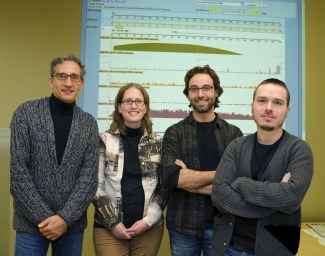Study Reveals Genomic Imprinting of Natural Selection

Discovering the relation between genetic variation and observable characteristics of individuals belonging to a species, such as a person's height or the manifestation of a hereditary disease, is one of today's challenges in biology. Until now only a small part of the variation of these traits - which biologists name phenotypes - were attributed to genetic variations.
An international project was carried out to be able to analyse the relation between genes and phenotype. One of the main researchers was UAB professor Antonio Barbadilla and his research group Bioinformatics for Genetic Diversity, in collaboration with the Comparative Genomics and Bioinformatics group led by UB professor Julio Rozas. The project has achieved to obtain the complete sequence of the gene of 168 lines preceding from the same population of Drosophila melanogaster (the common fruit fly, a model species used in the studies of genetics). The lines can be consulted by any scientist interested in studying the genetic base of a given phenotype. This is a truly in vivo library, maintained under laboratory conditions, which facilitates detecting genetic effects on the phenotype and permits discovering the genetic makeup of hereditary diseases.
The analysis of enormous amounts of data contained in the 168 complete genomes, a colossal task which required much efforts on behalf of specialists in bioinformatics and population genetics, is beginning to show results. The first ones can be consulted in Nature, which have been the detection of the mark left by natural selection all along the genome. A molecular signature natural selection has left on the genetic variation patterns seen in each region of the genome. All new mutation which contributes to adapting to the environment of an individual spreads rapidly to the rest of the species – a process known as adaptive selection. In contrast, there are regions of the genome in which all types of mutations end up being harmful and are finally eliminated from the population, in a process known as negative selection. Both selection processes leave characteristic molecular signatures on the genome. Through the comparison of genomes of a large number of individuals of the same species and of other similar species, scientists have been able to trace the first high resolution map of the natural selection of a genome in both regions which code proteins and those which do not.
Researchers observed that the mark left by natural selection is present along the genome, although the importance of different types of selection continues to depend on the type of functional areas and on the genome regions considered. For example, scientists observed that selection is more intense and effective in the X chromosome than in the rest of chromosomes, therefore representing a more rapid evolution of this sex chromosome. Another relevant observation is that the genetic recombination rate (variable along the genome) plays a fundamental role in improving the ability of adaptive selection in different regions of the genome. The probability of a genomic region responding effectively to natural selection depends on its recombinational context. In a region with little or no recombination, selection will not be able to prevent the functional degradation of the region.
For UAB professor Antonio Barbadilla, one of the main researchers in the project, "having 168 genomes of a single natural population is a unique opportunity to carry out the most complete genome study of a species ever done". "For all population geneticist it is a dream come true to be able to use a set of data as large as the one in this project to test many hypotheses which have been disputed in the past decades", Barbadilla adds.
To calculate, store, manage and visualise all variation data in the genomes, UAB researchers, in collaboration with UB researchers, designed and used the recently created navigator for population genome data: the Population Drosophila Genome Browser (PopDrowser). The navigator graphically represents all information extracted from genome sequencing including DNA sequencing, genomic annotations, estimations of nucleotide diversity; and calculates several statistical tests to determine the effect of natural selection at nucleotide level. The PopDrowser navigator is described in an article published on line in the journal Bioinformatics and can be consulted at http://popdrowser.uab.cat.
References
"The Drosophila melanogaster Genetic Reference Panel". Trudy F. C. Mackay, Stephen Richards, Eric A. Stone, Antonio Barbadilla, Julien F. Ayroles, Dianhui Zhu, Sònia Casillas, Yi Han, Michael M. Magwire, Julie M. Cridland, Mark F. Richardson, Robert R. H. Anholt, Maite Barrón, Crystal Bess, Kerstin Petra Blankenburg, Mary Anna Carbone, David Castellano, Lesley Chaboub, Laura Duncan, Zeke Harris, Mehwish Javaid, Joy Christina Jayaseelan, Shalini N. Jhangiani, Katherine W. Jordan, Fremiet Lara, Faye Lawrence, Sandra L. Lee, Pablo Librado, Raquel S. Linheiro, Richard F. Lyman, Aaron J. Mackey, Mala Munidasa, Donna Marie Muzny, Lynne Nazareth, Irene Newsham, Lora Perales, Ling-Ling Pu, Carson Qu, Miquel Ràmia, Jeffrey G. Reid, Stephanie M. Rollmann, Julio Rozas, Nehad Saada, Lavanya Turlapati, Kim C. Worley, Yuan-Qing Wu, Akihiko Yamamoto, Yiming Zhu, Casey M. Bergman, Kevin R. Thornton, David Mittelman & Richard A. Gibbs et al. Nature. 482: 173–178. 2012. doi:10.1038/nature10811.


